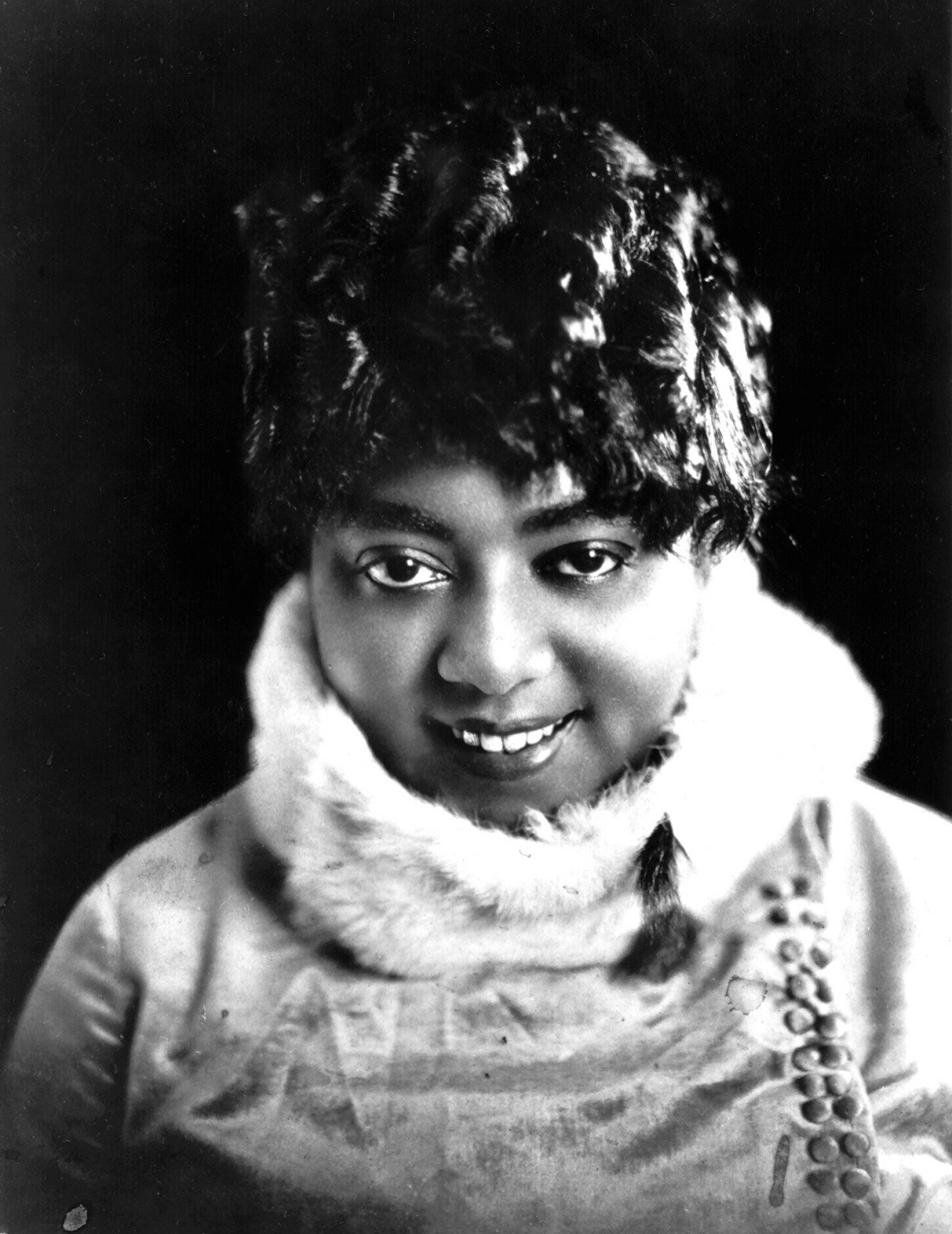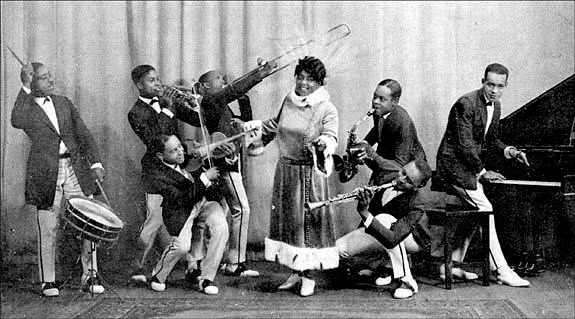Who Is Mamie Smith?

Name: Nee Mamie Robinson, Mamie Smith after marrying William “Smitty” Smith.
Life: May 26, 1883 – September 16, 1946. Thought to have been born in Cincinnati, Ohio, however there are no records of her birth.
Mamie Smith, a versatile vaudeville performer, is famous for being the first African American singer to record a vocal blues song. There had been a number of recordings by black artists pre-1920. As early as 1895 George W Johnson recorded ‘Laughing Song’, however early recordings “featured comic monologues and black college choral versions of religious music, but no blues…” [1]
Smith’s Contribution To The Blues
For black women, fighting against the oppression of severe racism and sexism, getting a recording contract was not easy. White record companies claimed that “the black women’s voices were unsuitable, or that their diction was different from that of white women, or that they could not fill the requirements.” [2]
Perry Bradford, a male African American musician and composer, knew of Mamie Smith after her performances in the ‘Maid of Harlem’ musical revue. Bradford arranged an appointment with RCA Victor Records in January 1920 and took Mamie Smith along to sing his composition. This first recording was never released. One month later they tried again with Okeh records, recording ‘That Thing Called Love’ (a vaudeville style song) and ‘You Can’t Keep a Good Man Down’ (a blues). The recording wasn’t released until the summer and was released as one of many records, with no special mention or promotion by Okeh Records. However the black press promoted the release and black Americans bought every copy they could find!
“Some estimates were in the 100,000 range, stupendous for the times, especially because these were sold exclusively to blacks.” [3]
Okeh quickly realised there was a whole market that they could tap into and recorded ‘Crazy Blues’, with the newly named Mamie Smith’s Jazz Hounds, in August 1920. This time they promoted the record, and the sales were incomparable. The success of ‘Crazy Blues’ gave rise to the new ‘race record’ industry (more information on this in future blogs) and opened the door for the whole era of Classic Female Blues.
Record companies saw the commercial and financial benefit of recording black artists and marketing these records to black communities. Recording companies started actively looking for black female artists to record and continue Mamie Smith’s success, each one billed as ‘the best yet’ or ‘the uncrowned queen of the blues’.

The impact of these new blues recordings was huge. Blues music was now available to buy and take home – it spread across the country quicker than a musician could travel, making the music accessible to new groups of people. In ‘Blues People’, LeRoi Jones states that phonograph records by female blues artists created whole new styles of blues singing: “it is easy to see how this must have affected the existing folk tradition and created another kind of tradition that was unlike any other in the past” [4]
“…increased improvisation on melodic lines, unusual phrasing which altered the emphasis and impact of the lyrics, and vocal dramatics using shouts, groans, moans and wails. The blues women thus effected changes in other types of popular singing that had spin-offs in jazz, Broadway musicals, torch songs of the 1930s and 1940s, gospel, rhythm and blues, and eventually rock and roll.” [5]
Smith continued recording for Okeh. Her recordings boosted her stage career and vice versa. In 1921 a review from one her shows in Dallas states [6]:
“one of the best accelerated musical treats of the year. [She] is a master of the art of Negro blues songs”
Mamie Smith became a star. She understood the success of her recording career was based on the success of the stage career and she wanted to look the part… sparkles, lavish costumes, beautiful scenery. Mamie Smith, in many way, set the scene for blues divas to come!
In 1921 Smith is quoted as saying:
“thousands of people who come to hear me… expect much, and I do not intend that they shall be disappointed. They have heard my phonograph records and they want to hear me sing these songs the same as I do in my own studio in New York… Another thing, I believe my audiences want to see me becomingly gowned, and I have spared no expense or pains… for I feel that the best is none too good for the public that pays to hear a singer.” [7]
However we must remember that it wasn’t all songs and sparkles. Mamie Smith and the other blues women of the 1920s would have lived a strange double life thanks to the Jim Crow Law (more information on this in future posts). The Jim Crow Law enforced segregation in the Southern United States and these queens of the stage would have been forced into a segregated life off stage, unable to sleep in hotels when they travelled, unable to eat in restaurants and unable to share any sort of transport with white folk. They risked their lives travelling to perform in the southern states, where lynchings were rife and extremist groups, such as the Klu Klux Klan, were growing in power.
But they did it. They risked their lives to sing the blues. And with this final thought I want to end this blog with another quote from ‘Black Pearls’ by Daphne Duval Harrison:
“That is why the blues women sang… They knew the blues was always lurking in the shadows, coming out to grab you, messing with you just when you thought things were going right. So the women sang – in tents, theatres, dance halls, cabarets, and on records; they exorcised the blues feelings in a communal ritual with other black folk.” [8]
See & Hear Mamie Smith In Action
If you would like a version of Crazy Blues with better sound quality then check out this version by Catherine Russell:
SOURCES
- www.redhotjazz.com/mamie.html
- Black Pearls: Blues Queens of The 1920s by Daphne Duval Harrison
- Blues People by LeRoi Jones
FOOTNOTES
[1] Black Pearls: Blues Queens of The 1920s by Daphne Duval Harrison, p44
[2] Black Pearls p45, from Levine, Black Culture, 224-225.
[3] Black Pearls: Blues Queens of The 1920s by Daphne Duval Harrison, p46
[4] Blues People by LeRoi Jones, pg102
[5] Black Pearls: Blues Queens of The 1920s by Daphne Duval Harrison, P8
[6] Black Pearls: Blues Queens of The 1920s by Daphne Duval Harrison, p47
[7] Black Pearls: Blues Queens of The 1920s by Daphne Duval Harrison, p48. (Quoted in Foreman ‘Jazz and Race Records’ p59)
[8] Black Pearls: Blues Queens of The 1920s by Daphne Duval Harrison, p4 (Footnote to Albert Murray’s Stomping the Blues, where he says that the function of blues music is to drive away the blues, to stomp them until they fade into the background.)



